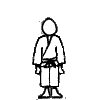Ambiperplexity
 In martial arts classes around the world:
Master demonstrates posture. Student watches. Student copies.
Student gets lefts and rights messed up.
In martial arts classes around the world:
Master demonstrates posture. Student watches. Student copies.
Student gets lefts and rights messed up.
Why? How hard can it be? Click the student when he strikes the same posture that the master demonstrated.




Watch the master when he demonstrates.
Remember: left and right swap over when the student turns round!
Click on the student:
gain 2 points if the posture matches the one the master just demonstrated,
lose a life if it doesn't.
Every time you miss a correct posture, you drop a point. You can lose up to half your points in any round this way.
Bonus life at the 10th round.
Yes, it does get harder and faster as the rounds progress.
hide instructionsAbout Ambiperplexity
(from p.22 of the book)
A common affliction amongst newcomers (and, indeed, many experienced practitioners) in the martial arts is that of ambiperplexity: confusion when trying to determine left from right. This condition typically lies dormant in most people until they begin a martial art, whereupon they unexpectedly discover they suffer from it, and thus require remedial coaching, like "Step with your left foot as the right hand comes —no, not that hand, the other one— with the other foot . . ." and so on.
The problem arises in many martial arts because stances generally require both hands and both feet to be in a very specific arrangement. Because the position of each hand or foot can be in one of two states (either right or wrong), there are a total of sixteen possible combinations for any simple stance. This means that a beginner striking a random pose has a probability of fifteen in sixteen (about 94%) of not getting it right.
The samurai of ancient Japan addressed the problem of ambiperplexity by (a) forbidding anyone to ever use a sword left-handed, and (b) spending most of their time kneeling down.

